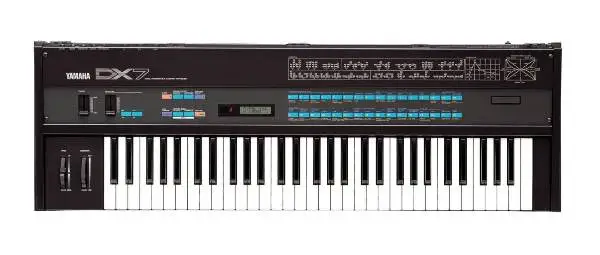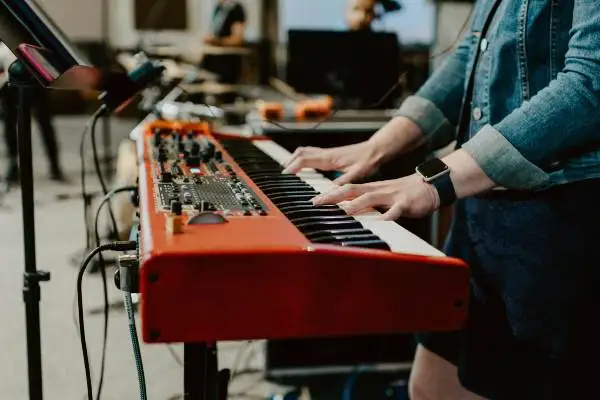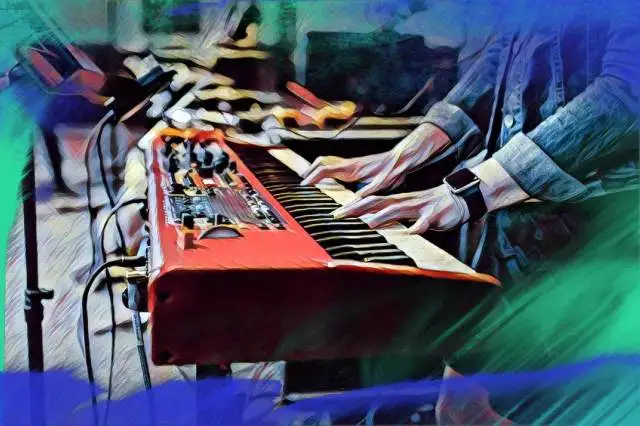Let’s talk about electric pianos.
If you’ve ever found yourself wondering how these common instruments produce sound without a single hammer or string, you’re in the right place. Electric pianos are like the cool cousin of the traditional grand piano - sleeker, more versatile, and a heck of a lot easier to lug around from gig to gig. But beneath that polished exterior lies some pretty fascinating technology that most people just don’t think about (even those who have been playing for several years).
So, in this article, we’re going to break down all there is to know about electric pianos. By the end, you’ll know how these instruments create sound, what makes them different from their acoustic cousin, and why they’re a must-have in any modern keyboardist's toolkit.
The History of Electric Pianos
Before we get into the weeds, let's take a little trip back in time, shall we?
Before electric pianos became the versatile instruments we know today, they had a pretty humble beginning. The story started in the early 20th century when musicians and engineers began experimenting with ways to amplify the sound of traditional pianos.
The goal was simple: create an instrument that could be heard over the din of a big band without requiring the player to hammer away like they were trying to break the keys.
Early Developments of Electric Pianos
The first real breakthrough came in the 1920s with the development of the Neo-Bechstein electric grand piano.
This early attempt at an electric piano used electrostatic pickups to capture the vibrations of the strings. While it was innovative, the sound quality wasn’t quite there, and the instrument never really took off.
However, the seed of the eventual digital piano had been planted.
Fast forward to the 1950s, and we see the rise of instruments like the Wurlitzer and the Fender Rhodes - two names that any piano enthusiasts will likely know well. The Wurlitzer, with its reed-based design, and the Rhodes, using tines instead of strings, became synonymous with the electronic piano sound of the era. These instruments had their own distinct voices that became staples in everything from jazz to rock.
The Evolution from Analog to Digital
Then came the 1980s, a decade that saw a massive leap forward with the introduction of digital piano technology.
The Yamaha DX7 , while technically a synthesizer, was one of the first digital instruments to really push the boundaries of what an electric piano could do. It featured FM synthesis, which allowed for more complex and realistic sounds than ever before.

Suddenly, electric pianos could mimic acoustic pianos with startling accuracy, or go in completely new sonic directions.
As the years rolled on, digital electric pianos continued to evolve. Today’s models now combine the best of both worlds: the authentic feel and sound of an acoustic piano with the versatility and convenience of digital technology.
Basic Components of an Electric Piano
To really get a grip on how electric pianos work, you’ve got to understand the parts that make them tick.
Let’s take a look at the basic components that come together to create the digital pianos we know and love.
Keyboard and Keys
The first and most obvious part of the digital piano is the keyboard. This is where the magic happens.
Just like an acoustic piano, an electric piano has a set of keys. Sometimes, it'll mimic a standard grand piano with 88 keys, though there are plenty of models with fewer. These keys can be made from plastic, wood, or a combination of materials, and they’re sometimes weighted to mimic the feel of an acoustic piano. The way they feel is known as the action . You can also describe it as the way the keys respond to your touch.
Some electric pianos even offer graded hammer action, where the lower keys feel heavier, just like on a real grand piano.
Sensors
Underneath those keys, you’ve got sensors.
These little guys are how the electric piano knows what note(s) you're playing. When you press a key, the sensors detect not just the fact that you’ve pressed it, but also how hard or soft you played it, otherwise known as the velocity.
This data is then sent to the sound engine, which uses it to generate the appropriate sound. The more advanced the sensors, the more expressive your playing can be. Some high-end models even feature triple sensors per key for ultra-precise detection, such as the Yamaha Clavinova series , Roland's LX and HP series , and Kawai's CA series.
Sound Engine
Here’s where things start to get interesting. The sound engine is the brain of the electric piano. It’s responsible for generating the sounds you hear when you play.
There are a couple of ways this can happen: sampling and synthesis. In sampled sound engines, real acoustic pianos have been recorded (or sampled) at various dynamics. When you hit a key, the engine plays back the corresponding sample. Synthesized sound engines, on the other hand, create sounds electronically, offering endless possibilities beyond just piano tones.
We'll get more into these two types of sound creation in a bit.
Amplifiers and Speakers
Of course, what good is a great sound if no one can hear it?
That’s why electronic pianos feature amplifiers and speakers.
The sound engine sends its output to the amplifier, which boosts the signal, and then the speakers project it into the room. Some electric pianos feature built-in speakers, and some don't. However, even those that do often provide the option to connect to external speakers or an amp for a more powerful, customizable sound.
Some models even allow you to adjust the sound output to match the acoustics of different environments.
Control Panel
Last but not least, we’ve got the control panel.
I like to think of it as the cockpit of an electric piano. It’s where you’ll find all the knobs, buttons, and sliders that let you tweak your sound. Almost all electric and digital pianos have different control panels, though you'll typically find common controls like volume, tone selection, effects (like reverb or chorus), and sometimes even recording and playback options.
While the layout can vary, the goal is always the same: to give you control over every aspect of your sound.
How Sound is Produced in an Electric Piano
Now let’s dig into how electric pianos create sound.

It all boils down to two main processes: sound sampling and sound synthesis. Together, these techniques allow electric pianos to produce a wide variety of tones, from the realistic timbre of an acoustic piano to the otherworldly sounds of synths, organs, and sound fx.
Sound Sampling
Sound sampling is a bit like creating a high-quality audio snapshot.
For example, if a keyboard manufacturer wanted to inject the sound of a real acoustic piano, they'd meticulously record it at different volumes, from the softest pianissimo to the loudest fortissimo. Each note would be captured at multiple dynamic levels to ensure that every nuance of the piano’s sound is preserved.
These recordings would then be stored in the piano’s memory.
When you play a key on an electric piano with a sampled sound engine, the corresponding recorded sample is played back through the speakers. The intensity with which you press the key determines which sample is triggered.
So, if you play softly, the piano will play back a softly recorded sample, and if you play with more force, a louder sample is triggered. This process creates a highly realistic sound that closely mimics an acoustic piano.
Sound Synthesis
Now, sound sampling, which relies on recordings of real instruments, is just one part of the equation. Then, we have sound synthesis, which generates tones electronically.
There are several methods of synthesis, and it would take quite a while to go through them all, so instead, we'll just discuss some of the most prominent.
Frequency Modulation (FM) synthesis, as we mentioned with the DX7, is one of the most well-known methods of synthesis. It works by modulating one sound wave with another to create complex tones. Over the years, it has become famous for its bright, metallic sounds, which you’ve no doubt heard in countless 80s pop songs.
Another method is physical modeling synthesis , which uses mathematical algorithms to simulate the physical properties of an instrument. This method is great for incredibly detailed and dynamic sounds, making it possible to replicate not just the sound of an instrument, but how it responds to different playing techniques.
Let’s say you’re replicating the sound of a grand piano using physical modeling. When you press a key softly, the model not only produces a gentle sound but also simulates the way the strings inside a real piano vibrate subtly and the way the hammers strike the strings with less force.
If you press the key harder, the sound becomes louder and more resonant, just like it would on an actual grand piano. If you use the sustain pedal, the model will simulate how the dampers lift off the strings, allowing them to resonate longer and even how sympathetic vibrations from other strings would contribute to the overall sound.
Suffice it to say, it's very detailed.
Some electric pianos also use additive synthesis , where sounds are created by adding together multiple sine waves, each of which represents a different harmonic of the desired tone.
Digital Signal Processing (DSP)
Once the sound is generated, whether through sampling or synthesis, it often goes through Digital Signal Processing (DSP) to enhance its quality. With DSP, we can add effects like reverb, chorus, and EQ, which can make a huge difference in how the piano sounds in different environments.
The reason DSP is so powerful is that it allows you to tailor the sound to your liking. Whether you’re going for a classic, warm piano sound or something more experimental, DSP gives you the tools to fine-tune the output.
Types of Electric Pianos
Electric and digital pianos come in all shapes and sizes. Let’s break down the most common types you’ll encounter and what makes each of them unique.

Stage Pianos
Stage pianos are the go-to choice for gigging musicians. These musical instruments are designed to be portable, durable, and versatile, making them perfect for live performances. Unlike their bulkier cousins, they are typically lightweight and come with versatile sound engines, customizable effects, and plenty of inputs and output.
However, they often lack built-in speakers, which usually isn’t a problem since they’re often plugged into external sound systems.
The beauty of stage pianos is that they also tend to offer a wide range of voices, from classic grand pianos to strings, organs, and synth sounds. This makes them ideal for musicians who need to switch between different tones quickly during a performance.
Digital Upright Pianos
If you’re looking for something that feels and sounds like a traditional piano but doesn’t take up as much space or require as much maintenance, a digital upright piano might be the perfect fit.
These musical instruments are designed to mimic the look and feel of an acoustic upright piano, with full-sized, weighted keys and built-in speakers that deliver a rich, resonant sound.
Digital upright pianos often have recording capabilities, various sound presets, and connectivity for headphones and other devices. They’re a great choice for home use, especially if you’re looking for a piano that doesn’t need to be tuned and can be played at any time of day without disturbing the neighbors.
Plus, they often have a more traditional aesthetic, making them a nice addition to your home decor!
Hybrid Pianos
Hybrid pianos are where acoustic meets digital.
These instruments combine the physical components of an acoustic piano, like real hammers and strings, with the technology of modern digital pianos. The result is an incredibly realistic playing experience that captures the best of both worlds.
When you play a hybrid piano, you get the tactile feedback of a traditional acoustic piano, but with the added benefits of digital piano features like unique sound presets, silent playing modes, and the ability to record your performances without setting up a bunch of mics.
You'll often find these types of pianos in professional studios or concert halls, though they're great for any serious pianist who wants the authentic feel of an acoustic piano without the need for regular tuning or maintenance.
It's worth noting that they can be on the pricier side, but for those who demand the highest level of realism, they’re worth every penny.
Portable Keyboards
For musicians on the move, portable keyboards are the ultimate tool. They're designed for versatility, making them ideal for practice, composing, or just jamming out wherever you are. Portable keyboards come in a range of sizes, with varying numbers of keys, and are usually much lighter than other types of electric pianos.
However, just because they're small doesn't mean they lack power. Many portable keyboards come packed with features, including a variety of instrument and piano sounds, rhythmic accompaniments, and even built-in learning tools.
I recommend them for beginners or musicians who need a lightweight, affordable instrument that they can take anywhere.
Differences Between Acoustic and Electric Pianos
When it comes to acoustic and electric pianos, both types of pianos have their own unique qualities, as well as the way they produce sound and handle touch. Let's take a look at some of the most important differences between the two.
Sound Production Mechanism
The most fundamental difference between acoustic and electric pianos lies in how they produce sound.
Traditional acoustic pianos are entirely mechanical. When you press a key, it triggers a hammer to strike a set of strings, which vibrate to produce sound. The sound resonates within the piano’s wooden body, creating the rich, full tones that acoustic pianos are known for.
Electric pianos, on the other hand, replicate these sounds digitally. Instead of strings, they use either sound sampling or sound synthesis , as we mentioned earlier.
Touch and Feel
The touch and feel of the keys are crucial for any pianist, and this is another major area where acoustic and electric pianos differ. Acoustic pianos have a natural weight and resistance in their keys due to the mechanical action of the hammers and strings.
The keys are usually heavier in the lower registers and lighter in the upper registers, which provides a dynamic playing experience.
While some electric and digital pianos have weighted keys or graded hammer action, most digital pianos use semi-weighted keys.
Semi-weighted action combines elements of both weighted and unweighted keys. Springs are added to the keys, along with a bit of additional weight, making them faster and lighter than fully weighted keys but with more resistance than unweighted keys.
You'll also find unweighted or synth action keys on some electric and digital pianos, which are light and responsive, much like the keys on a synthesizer or organ. This type of action is great for speed and ease of playing, though it lacks the resistance and feel of an acoustic piano, making it less suitable for traditional piano playing.
Maintenance and Durability
One of the biggest advantages of electric pianos is their low maintenance. Acoustic pianos need regular tuning, which can be costly and time-consuming, especially if the piano is moved frequently or exposed to changes in humidity.
The strings, hammers, and other mechanical parts of an acoustic piano can also wear out over time and may require professional servicing.
Electric or digital pianos, on the other hand, don’t require tuning and generally have fewer components that can wear out. As long as they’re kept in a stable environment and treated with care, they can last for many years with minimal maintenance.
Versatility and Features
Electric and digital pianos really shine in their versatility.
Acoustic pianos have one sound - albeit a beautiful and complex one - but that’s it. Electric and digital pianos offer a variety of sounds and features that can take your music in countless directions. Whether you want to switch from a grand piano sound to an electric organ, add reverb or chorus, or even layer multiple sounds together, electric and digital pianos give you the tools to do so with just a few button presses.
Many electric and digital pianos also come with built-in metronomes, recording capabilities, and connectivity options for headphones, MIDI controllers, and other digital devices. This makes them incredibly versatile for everything from practice to recording to live performance.
The Future of Electric and Digital Pianos
Electric pianos have come a long way, and the pace of innovation shows no signs of slowing down. With each passing year, electric and digital pianos are improving at a drastic rate, and many new ones seem to get closer and closer to the real thing.
Many are even starting to push the boundaries of what we thought was possible.
Take, for example, MPE (MIDI Polyphonic Expression) keyboards like the Osmose and the Seaboard . These unique instruments are redefining the way we interact with keyboards by allowing for incredibly nuanced control over each note. Instead of simply pressing a key, you can press, slide, and modulate each note independently, opening up new dimensions of expressiveness that were previously unimaginable. They’re fundamentally changing how we think about and play keyboard instruments.
At the same time, computers are getting faster and smarter, allowing for even more sophisticated sound engines, AI integration, and connectivity options.
In the end, the future of electric and digital pianos is bright, and I'm excited to see how they continue to evolve!





